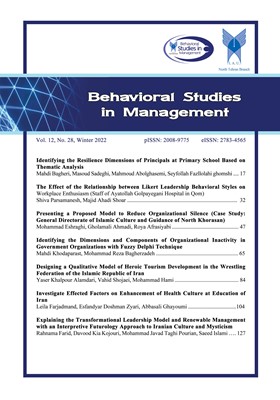Presenting a Proposed Model to Reduce Organizational Silence (Case Study: General Directorate of Islamic Culture and Guidance of North Khorasan)
Subject Areas : Behavioral Studies in ManagementMohammad Eshraghi 1 , Roya Afrasiyabi 2 , Gholamali Ahmadi 3
1 - PhD Student in Educational Management, Islamic Azad University, North Tehran Branch, Tehran, Iran
2 - PhD in Educational Management, Faculty of Humanities, Islamic Azad University, Bojnourd Branch, Iran.
3 - Associate Professor, Faculty of Humanities, Tarbiat Dabir Shahid Rajaei University.
Keywords: Organizational silence, silence, Organizational behavior, Organizational Silence Factors,
Abstract :
Although in today's fast-paced world, enjoying the ideas, suggestions and ideas of employees is one of the prerequisites for organizational development and one of the factors influencing organizations to outperform competitors, the emergence of several factors has led employees to participate in They do not express their views in organizations and in other words they prefer to remain silent. Despite the differences in the definitions of thinkers, they all agree on one thing, the lack of knowledge, information and opinions of employees that can cause serious damage to both the organization and the employee. Among the reasons for this phenomenon in the studies can be imagined by the manager's inability to do the job, the perception that they will not receive a positive response, the perception that it might harm others, the personality characteristics of the senior manager, the way staff interact, the fear of managing negative feedback, and Population differences and other reasons cited. The purpose of this study was to identify the factors causing organizational silence and its possible consequences by qualitative and thematic analysis based on interviewing method and by quantitative method using questionnaire. The statistical population of the present study consists of the North Khorasan Islamic Culture and Guidance Bureau, which was selected by stratified sampling method and Lisrel8, MAXQDA10 and Spss18 softwares were used for data analysis. After analyzing the data, factors such as lack of meritocracy, fear, lack of motivational managers, managers' mental attitudes, employee profitability, social learning have been identified and discussed as factors causing organizational silence.
آقاباباپور دهکردی، طاهره و نصراصفهانی، علی (1392)، بررسی رابطه هویت سازمانی و سکوت سازمانی کارکنان، مجله علمی پژوهشی جامعه شناسی کاربردی، سال 24، شماره پیاپی 52، شماره چهارم، 139-162.
زارعی متین، حسن، طاهری، فاطمه و ابوالقاسم سیار، (1390)، سکوت سازمانی: مفاهیم، علل و پیامدها، فصلنامه علوم مدیریت ایران، سال ششم، شماره 21
شریفی، احسان ا...(1392)، راهکارهای پیشنهادی جهت حداکثر کردن بهرهوری استفاده از خلاقیت در محیط کار، EHSANSHARIFI.IR.www
علی بابایی، یحیی، (1392)، آموزش نرم افزار آماری لیزرل (LISREL) به زبان ساده، مشاوره اخبار ارشد و دکتری
قدسی، محمدرضا، (2017)، سکوت کارمندان نشانه چیست؟، پایگاه اطلاع رسانی تأمین اجتماعی، کد مطلب 4129
Brinsfield, C. T. (2009). Employee silence: Investigation of dimensionality, development of measure, and examination of related factors (Doctoral dissertation, The Ohio State University).
Cinar, O.; Karcioglu, F. & Aliogullari, Z, D. (2013).” the relationship between organizational silence and organizational citizenship behavior: a survey study in province of Erzurum, Turkey”, Social and Behavioral Sciences, 99: 314 – 321.
Clemmer, J. (2008). “Moose on the Table: A Novel Approach to Communications at Work”. Ecw Press. upward and why”. Journal of Management Studies, 40(6), 1453-1476
Karaca, H. (2013),”an exploratory study on the impact of organizational silence in hierarchical organization: Turkish National Police Case”, European Scientific Journal, vol.9, No.23, pp. 38-50
Liu, D.; Wu, J. & Ma, J. (2009). “Organizational silence: A survey on employees working in a telecommunication company”, Computers & Industrial Engineering, IEEE Conference Publications, pp.1647– 1651
Morrison, E. W. and Milliken, F. J. (2000). ‘Organizational silence: a barrier to change and development in a pluralistic world’. Academy of Management Review, 25, 706–25
Penttila, Chris. (2003),” Get Talking ”, Entrepreneur, p 25
Pinder, C. &. Harlos H. P (2001). “Employee silence: Quiescence and acquiescence as responses to perceived in justice”. Research in Personnel and Human Resource Management, 20, 331-369
Sennett, R, (1998). The corrosion of character: the personal learning and interpretation in strategic persistence and reorientation: an empirical exploration. Strategic management Journal, 13: 585-608
Ting Liang, Ying Wang (2016), " Organizational Silence in State-Owned Enterprises: Intermediary Role of the Perceptions of Organizational Politics " American Journal of Industrial and Business Management, 2016, 6, 640-648
Vakola, M., & Dimitris B. (2005), “Antecedents and consequences of organizational silence: an empirical investigation”. Employee Relations, 27,pp. 441-58
Yıldız, E., (2013), “Enigma of Silence in Organizations: What Happens To Whom and Why?”, Beykent University Journal of Social Sciences,Vol.6 No.2, pp.30-44
Zehir, C., & Erdogan, E. (2011),”The Association between Organizational Silence and Ethical Leadership through Employee Performance”, Procedia Social and Behavioral Sciences, 24,pp. 1389- 1404
_||_

